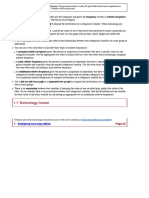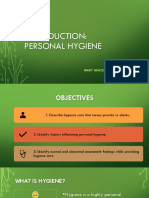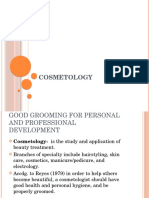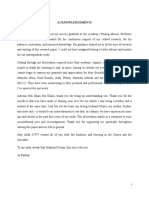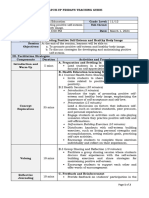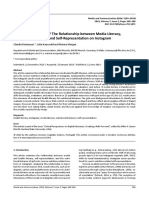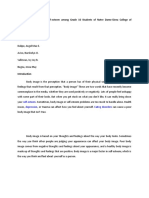Argumentative Text
The Influence Of Social Media On Teenagers' Mental Health And Well-Being: A Complex
Dynamic
The role of social media in shaping teenagers' mental health and well-being is a widely
debated topic, with experts divided over its potential benefits and harms. On one hand, social
media platforms offer teenagers unprecedented access to information, peer connections, and
creative expression. On the other hand, these same platforms have been associated with
increased rates of anxiety, depression, and feelings of isolation. Understanding the impact of
social media on adolescents requires a nuanced approach that considers both the positive and
negative aspects of its influence.
Firstly, social media provides a unique space for teenagers to form and maintain social
connections, particularly in an increasingly digital world. For many teens, platforms like
Instagram, Snapchat, and TikTok allow them to stay in touch with friends, especially those who
live far away or attend different schools. These platforms offer opportunities to share
experiences, exchange ideas, and support one another. Studies have shown that online social
interaction can enhance feelings of belonging and reduce loneliness, particularly for those who
struggle with face-to-face interactions due to social anxiety or geographic isolation.
Furthermore, social media allows teenagers to explore their identities and express
themselves in ways that may not be possible offline. Adolescence is a critical time for identity
development, and many teens use social media as a platform to experiment with different aspects
of their personality, style, and values. Whether through sharing art, music, or opinions, social
media provides a space for creative self-expression that can boost self-esteem and foster a sense
of individuality. Teens can also connect with communities that share their interests or
experiences, which can be empowering and validating.
However, the flip side of this is that social media can also create significant pressure to
conform to societal expectations. Teenagers are particularly susceptible to the influence of their
peers, and social media amplifies this by providing constant comparisons. Whether it’s the
number of "likes" on a post or the polished, idealized versions of lives that influencers project,
teens often feel pressure to measure up to unrealistic standards. This comparison culture can lead
�to feelings of inadequacy, anxiety, and low self-worth, particularly when teenagers start to equate
their online popularity with their real-life value.
Another major concern surrounding social media use among teenagers is the impact it has
on mental health, particularly with regard to body image issues. Platforms that prioritize visuals,
such as Instagram, often showcase a narrow definition of beauty, emphasizing unrealistic body
types and lifestyles. Teenagers, especially young girls, may internalize these ideals and develop
negative body image perceptions, leading to disordered eating, low self-esteem, or even
depression. Research has consistently shown a correlation between excessive social media use
and body dissatisfaction among adolescents.
Moreover, social media can foster a toxic environment of cyberbullying and harassment.
The anonymity and distance provided by the internet often embolden individuals to say things
they wouldn’t normally say in person. For teenagers, who are still developing emotionally, the
effects of cyberbullying can be devastating. Victims of online harassment are more likely to
experience depression, anxiety, and in extreme cases, suicidal thoughts. The constant availability
of social media means that there is no escape from bullying, further exacerbating its impact.
It’s also important to consider the addictive nature of social media. Many platforms are
designed to keep users engaged for as long as possible, using techniques like infinite scrolling
and notification alerts. This can lead to excessive screen time, disrupting sleep patterns and
contributing to a sedentary lifestyle. Sleep deprivation, in turn, has been linked to a range of
mental health issues, including mood swings, anxiety, and depression. For teenagers, whose
brains are still developing, the compulsive use of social media can interfere with cognitive
functions such as attention, memory, and decision-making.
On the positive side, social media can serve as a tool for mental health awareness and
support. Many teenagers use these platforms to seek advice and share their struggles with mental
health. Online communities dedicated to mental health advocacy provide a space for teens to
connect with others who share similar experiences, reducing feelings of isolation. Additionally,
social media campaigns and influencers who promote mental health awareness can help
destigmatize mental health issues, encouraging teenagers to seek help when they need it.
� However, the rise of “toxic positivity” on social media, where users are expected to
maintain an unrealistically positive outlook, can undermine genuine discussions about mental
health. Teenagers may feel pressured to present a facade of happiness, even when they are
struggling. This can lead to emotional suppression, which has been linked to increased anxiety
and depression. In contrast, platforms that allow for authentic, vulnerable discussions about
mental health can be a valuable resource, helping teens develop healthier coping strategies.
The algorithm-driven nature of social media platforms also plays a significant role in
shaping the content that teenagers consume. Algorithms are designed to show users content that
aligns with their interests, which can create echo chambers where teens are repeatedly exposed to
the same ideas, behaviors, or body ideals. This can reinforce negative thought patterns or
unhealthy behaviors, such as extreme dieting or self-harm. However, when used responsibly,
algorithms can also help teens discover educational resources, mental health support groups, and
positive role models.
To mitigate the negative effects of social media, it’s essential for teenagers to develop
healthy habits regarding its use. Digital literacy education can empower teens to critically
evaluate the content they consume and understand how social media platforms are designed to
manipulate their attention. Encouraging teenagers to set boundaries on their social media use,
such as limiting screen time and taking regular breaks, can also reduce the risk of addiction and
its associated mental health issues.
Parents, educators, and policymakers also have a role to play in ensuring that social media
is a positive influence on teenagers’ mental health and well-being. Open communication about
the risks and benefits of social media use can help teenagers navigate these platforms more
mindfully. Additionally, social media companies should be held accountable for creating safer
environments, with stricter policies on cyberbullying and more transparency about the effects of
their algorithms.
In conclusion, the influence of social media on teenagers’ mental health and well-being is
complex and multifaceted. While social media provides opportunities for connection, self-
expression, and mental health advocacy, it also presents significant risks, including body image
issues, cyberbullying, and addiction. The key to ensuring that social media is a positive force in
teenagers' lives lies in education, responsible use, and the development of healthier online
�communities. By fostering awareness and promoting balance, we can help teenagers harness the
benefits of social media while minimizing its harms.





























































